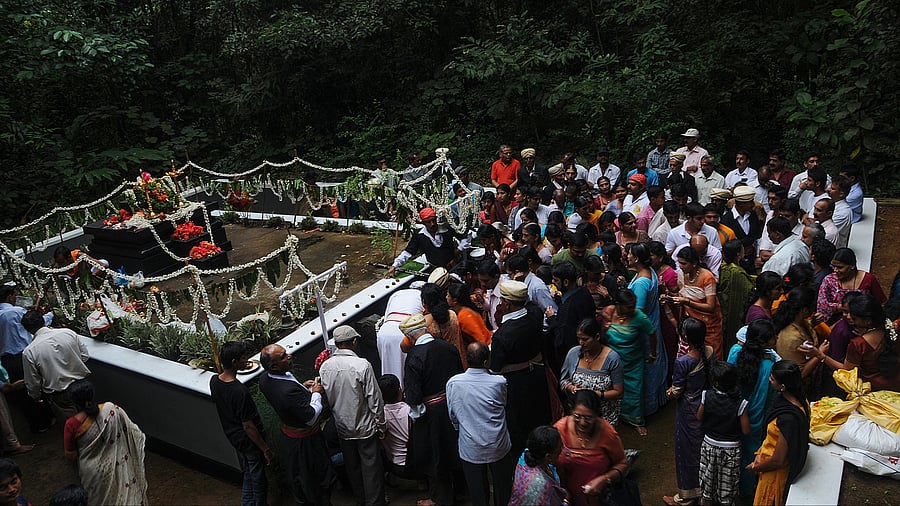
The local community gathers at a sacred grove in Kodagu district.
Credit: Special Arrangement/Bishan Monnappa
The nearly 500 families of Yalakundli hamlet in Shivamogga’s Sagar taluk eagerly wait for the onset of the Ardra Nakshatra rain. The residents believe that 'Ardra Nakshatra', which commences in the second half of June, marks the beginning of the monsoon rains. On the first Tuesday after this sets in, residents venture into a 40-acre pristine patch of the sacred forest — Rachammana Kaadu. Here, they offer special prayers seeking good rainfall and prosperity for the village.
“At the core of this sacred forest is our deity Rachamma, the protector of the village, residing under the nagasampige tree. The tree is at least 200 years old. The entire village, consisting of many communities, offers pooja to the goddess to welcome the rains. Later, the idols are taken out in a grand procession. This entire process has built unity and co-operation among the communities living in the hamlet,” says Praveen, a resident of the village.
The sacred grove is an integral part of various tribal communities’ cultures. Not a blade of grass in this protected area is harvested for commercial purposes, even though there are several high-value trees, including the dhoopa, Ashoka and nagasampige trees.
“The well-being of the devarakaadu is directly proportional to our well-being. This evergreen forest patch provides us with water all through the year for both agricultural activities and daily needs,” says Manjunath, the former secretary of the Rachammana Kaadu committee.
The concept of devarakaadu or sacred forests used to be common across Karnataka. Local communities would protect a selected patch of forest for many purposes — to maintain ecological balance, harvest rainwater, grow medicinal herbs and most importantly, foster a spirit of community.
Almost every village would have these sacred groves, where the cutting of trees was forbidden. Locals would be allowed to harvest minor forest products for sustenance purposes only. However, over the years, these forests have been slowly vanishing due to encroachment and development. In many cases, locals are not given ownership of the area.
Over the years
Today, these sacred groves have been limited to the Western Ghats districts. They are known by different names: kaan in Malnad, devakaad in Kodagu and nagabanas in Dakshina Kannada.
Experts say that the devarakaadu concept introduced traditional systems of temple management, by designating certain families as temple heads, guardians, temple treasurers, dancers and priests. The nature temples were also institutions that administered social justice. Heads of communities formulated rules of social order and local governance with the ‘blessings’ of local deities.
The very purpose of creating these forest patches, which ranged from two to three acres to over 100 acres, in the name of these deities, was to ensure long-term conservation.
Environmental writer Shivanand Kalave, who has extensively studied sacred groves, says, “To protect such patches of evergreen forest, which had springheads, they coined the concept of devarakaadu,” he says. He adds that even in arid regions like Bidar, the concept of sacred groves existed.
“Invoking the name of the gods and goddesses ensured long-term conservation. This is why most of the existing sacred forests are densely wooded and have diversity. The patch used to act as a seed bank for the rest of the forest area,” he says.
Today, it is unfortunate that we have limited ourselves to planting selected varieties, particularly commercial trees, which have high timber value, he adds.
While there is no specific data regarding the total number of devarakaadus present in Karnataka, activists say that the state might have already lost more than 60% of its area to encroachment.
Agricultural expansion has been the main cause behind the disappearance of devarakaadus.
Community action
However, activists point to a ‘silent revolution’. Local communities have been making efforts to protect more than 2,000 acres of sacred forests near Kantanahalli, Halesoraba, Kakkarasi, Chowdikkanu, Udri, Jade Kotekan, Holemaruru, and others in Shivamogga district through the Vruksha Laksha Andolan and Parisara Jagruthi Trust.
Ananth Hegde Ashisara, former chairman, Karnataka Biodiversity Board, says courts and the law have given several powers to gram panchayats and local communities to protect these sacred groves. “However, not many are aware of these provisions and are succumbing to political pressure and parting with these forest lands,” he says.
G P Ganesh Ayanna, a Kodagu-based social activist, says, in the Kodava culture, nature and ancestor worship are common.“Kodagu is a highly ecologically sensitive area. These groves used to play an important role in preventing landslides as the canopy would prevent the soil from eroding topsoil.”
He says monoculture plantations have replaced the 200 to 300-year-old trees, making the area more prone to natural disasters.“In 2018, Kodagu witnessed large-scale landslides, the majority of those areas were where forest land had lost trees. However, none of the devarakaadu areas witnessed this,” says Ganesh.
The first survey of devarakaadus, conducted by the British in 1873 in Kodagu, recorded 873 sacred groves, with a total area of 4,398 hectares. In 1905, the total area increased to 6,277 hectares. However, in 1991, when the Forest Department conducted a survey, it said there were 1,214 groves with an area of 2,550 hectares.
Cheppudira G Kushalappa, former dean of the Ponnampet Forestry College, says there are 121 deities and unique forms of worship practised by 18 local communities in Kodagu. As these groves are distributed throughout the landscape, they also represent diverse microclimatic conditions and associated biodiversity, he says.
Kushalappa says the informal conservation method, where locals get the proprietorship of conserving forest patches around them, needs to be encouraged.